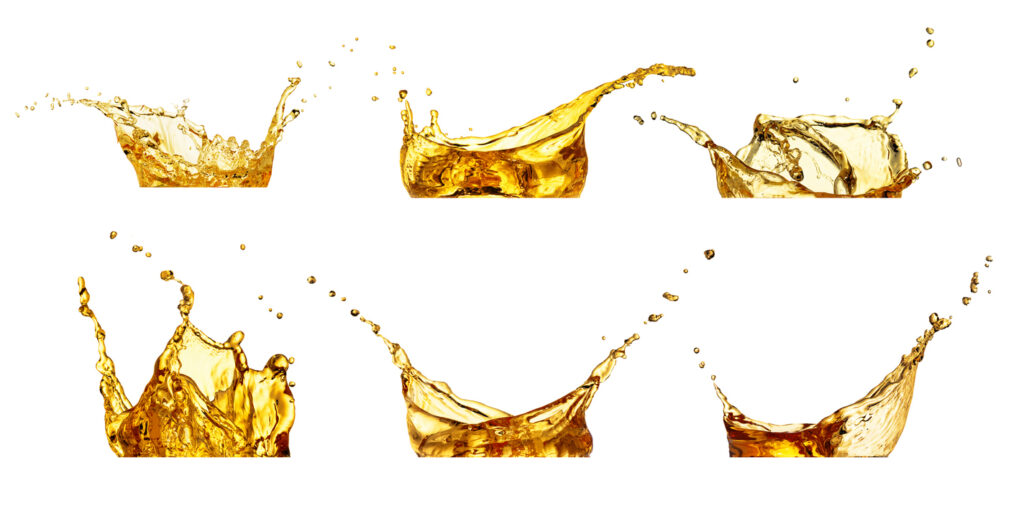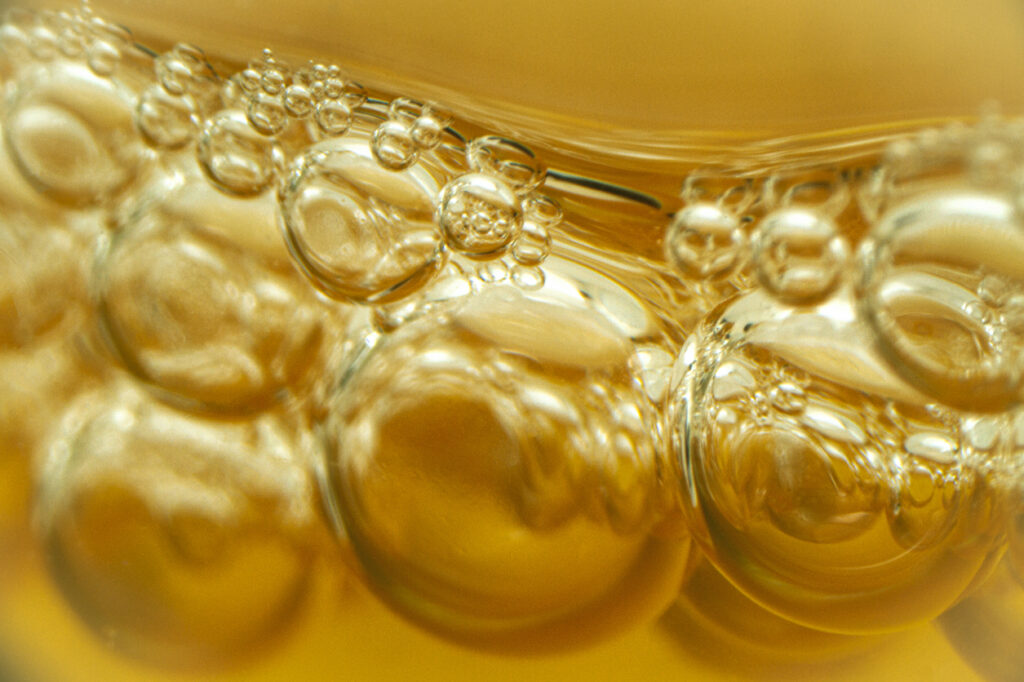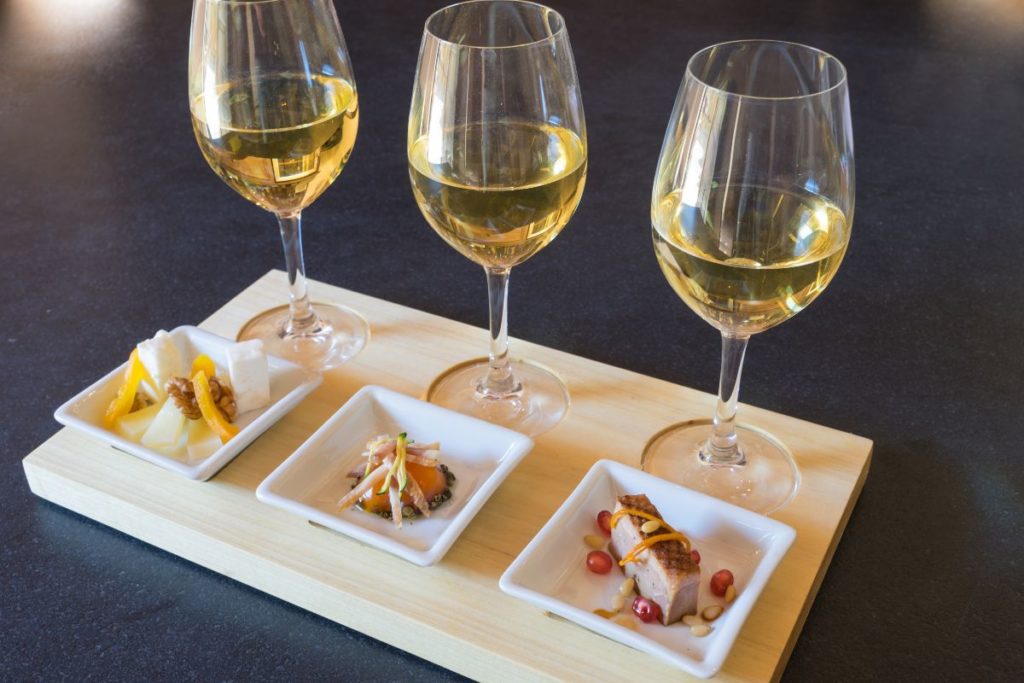Orange wine, a distinctive and intriguing addition to the world of wines, has been capturing attention in recent years. Contrary to what its name may suggest, orange wine is not made from oranges; rather, it is a type of white wine made by leaving the grape skins and seeds in contact with the juice, giving it a deep orange hue. The process of making orange wine involves mashing up white grapes and placing them in a large vessel, often made of cement or ceramic.
These wines are made all over the world from a diverse variety of white wine grapes. The exact hue and tannin profile of an orange wine depend on the grape varieties used, as well as the amount of time the juice spends macerating with the skins. Although orange wines may have gained popularity more recently, they have a long history and could be considered one of the earliest wine styles, tracing their origins to ancient winemaking practices.
Far from being just a trend, orange wines offer a unique taste and complexity that can appeal to wine enthusiasts and novices alike. With their amber or dark orange color and an array of flavor profiles, these wines defy expectations and invite exploration, making them a captivating topic for discussion and delight in the world of wine.

Fundamentals of Orange Wine
White Grapes and Skin Contact
Orange wine is made from white grapes, but it gets its unique characteristics through extended skin contact during the fermentation process. Unlike traditional white wines, where grape skins are quickly separated from the juice, orange wines are fermented with the skins and seeds in contact—the same method used in making red wines. This extended contact period imparts an orange hue to the finished product and gives the wine its distinct flavor and aroma profile.

Tannin and Dry
One of the main characteristics of orange wines is their high tannin content. Tannins are naturally occurring compounds found in grape skins, seeds, and stems. They can add a drying sensation and astringency to wines, which is more commonly associated with red wines. The skin contact method used to make orange wines results in a higher tannin content and contributes to their dry, full-bodied flavor. This tannic structure is often appreciated by fans of more robust reds, making orange wines an intriguing option for those looking to explore new wine styles.
Natural Wine Movement
Orange wines have gained popularity in recent years, in part due to their association with the natural wine movement. Natural wines are produced with minimal intervention, focusing on organic or biodynamic grape growing and low- to no-additive winemaking techniques. Although not all orange wines fall under the natural wine umbrella, the majority are produced using traditional methods that align with the movement’s ethos. These methods can include fermenting in clay vessels called qvevri, a practice with an 8,000-year-old history in Georgian winemaking. The combination of unique flavor profiles, natural winemaking techniques, and historical roots has made orange wines an attractive choice for wine enthusiasts seeking exciting and unconventional options.

Origins and Traditional Production
Georgia and Qvevri
Orange wine has its origins and traditional production methods rooted in the ancient winemaking traditions of Georgia. Considered one of the world’s oldest wine-producing regions, archeological evidence suggests that Georgian winemaking dates back over 8,000 years. Their unique winemaking technique uses a vessel called a “qvevri,” which is a large, egg-shaped clay container buried underground. This traditional method involves fermenting and aging the wine with the grape skins and seeds still present, giving the white wines their characteristic orange hue.
- Qvevri: Large, egg-shaped clay vessel used for fermenting and aging wine
- Grape skins and seeds: Essential to creating the orange color in the wine

Georgian winemakers continue to use qvevri in the production of orange wine, preserving and popularizing this ancient tradition.
Amphora and Clay Vessels
Apart from qvevri, there is another ancient vessel used in the production of orange wine. The amphora, a Greek and Roman earthenware container, also plays a role in the history and development of orange wine. Like qvevri, amphorae are typically made from clay and have been used for centuries to ferment and store wine. The grape juice and solid parts are placed inside the amphora and left to ferment and age, impregnating the liquid with a deep, intense hue.
- Amphora: Earthenware container used for fermenting and storing wine
- Clay vessels: Their temperature-regulating properties help maintain optimal fermentation conditions
Amphorae and other clay vessels are suitable for orange wine production because their natural temperature-regulating properties help maintain optimal fermentation conditions. The revival of interest in these ancient winemaking methods has contributed to the growing popularity of orange wine worldwide.

Popular Grape Varieties for Orange Wine
Chardonnay
Chardonnay is a versatile white grape variety that can be used to produce orange wines. When made in this style, Chardonnay offers a rich texture and complex flavor profile. The wine may feature notes of apple, pear, and citrus, as well as nutty and creamy undertones.
Pinot Gris
Pinot Gris is a popular grape variety for making orange wine, particularly in northeastern Italy, where it is known as “ramato.” The resulting orange wines from Pinot Gris have a copper or auburn hue and often display flavors of stone fruit, honeydew melon, and almond.
Sauvignon Blanc
Sauvignon Blanc is another grape variety often used in the production of orange wines. The process generally imparts a more prominent herbal and grassy quality to the wine, complementing the grape’s inherent notes of citrus and green apple.

Malvasia
Malvasia, a diverse family of white grape varieties, is well-suited for orange wine production. Malvasia-based orange wines typically exhibit floral aromas and flavors of peach, apricot, and tropical fruit, along with a honeyed character.
Chenin Blanc
Chenin Blanc, originating from the Loire Valley in France, is also a viable option for orange wine production. When made into orange wine, Chenin Blanc offers a rich, full-bodied texture with notes of pear, quince, and baked apple, sometimes accompanied by a hint of honey.
Riesling
Riesling is a versatile white grape variety that can yield high-quality orange wines. Orange wines made from Riesling often exhibit vibrant acidity, with a flavor profile that includes notes of lime, green apple, and flinty minerality.

Savagnin
Savagnin is a lesser-known white grape variety but plays a role in the world of orange wines. This grape creates wines with a pronounced nutty and oxidative character, often displaying flavors of green apple, citrus, and almond, with a touch of salinity.
Muscat
Muscat, a widely cultivated white grape variety, contributes to the production of aromatic orange wines. Typical flavor profiles for Muscat-based orange wines include floral, tropical and stone fruit notes, that can be balanced by a slightly bitter finish.
Key Regions for Orange Wine Production
Languedoc
Languedoc, a region in the South of France, is known for its diverse wine production, including the production of orange wines. The climate of Languedoc, with its warm Mediterranean influence and wide range of terroirs, allows for the cultivation of various grape varieties suitable for orange wine production. The region is predominantly known for its white grape varieties, which are typically used in the production of orange wines. These include Grenache Blanc, Vermentino, and Mauzac, among others.
In Languedoc, winemakers utilize traditional methods of orange wine production. Extended skin contact is employed which involves fermenting the grape juice with the grape skins to extract color, tannins, and flavors. This technique gives Languedoc orange wines their distinctive amber color, as well as their unique aromas and flavors.

Georgia
Georgia is considered the birthplace of orange wine, with a winemaking tradition that dates back over 8,000 years. Located in the Caucasus region, Georgia has a diverse range of microclimates and terroirs that are suitable for producing different styles of orange wines.
The most common grape varieties used for orange wine production in Georgia are Rkatsiteli, Kisi, and Mtsvane. These are indigenous to the region. One of the unique aspects of Georgian orange wine production is the use of qvevri, large clay vessels buried in the ground. They are used for fermentation and aging. The qvevri method imparts distinct earthy notes and complexity to the resulting orange wines.
In recent years, Georgian orange wines have gained international recognition. This is based on their quality, uniqueness, and the preservation of ancient winemaking techniques. These aspects have contributed to the growing interest and appreciation of orange wines from Georgia around the world.

Overall, Languedoc and Georgia stand out as key regions for orange wine production. Each with their distinct grape varieties, winemaking techniques, and terroirs that contribute to the uniqueness of their orange wines.
Famous Orange Wine styles
Vin Jaune
Tasting Notes
Orange wine is an unusual type of wine that has been gaining popularity in recent years. It is made using white grapes. They are left in contact with the skins, seeds, and stems for several days or even months. That`s how orange wine gets its unique flavor profile from the oxidation process that occurs during fermentation. Here are some typical flavors you can expect to find in orange wine:

- Citrus: As might be expected from a wine made from white grapes, citrus flavors are common in orange wines. You’ll often taste lemon, grapefruit, and orange zest.
- Stone Fruit: Another common flavor found in orange wines is stone fruit such as peach, apricot or nectarine. These fruity notes add a touch of sweetness to the otherwise dry profile.
- Spice: Some orange wines have a spicy finish. It’s reminiscent of nutmeg or clove which adds dimension to the overall taste experience.
Pairing Suggestions
Orange wine, also known as skin-contact wine or amber wine, is becoming increasingly popular among wine enthusiasts. Its unique flavor profile and versatility make it a great addition to any meal. However, finding the right food pairings can be a challenge.
One classic pairing for orange wine is with charcuterie and cheese boards. The bold flavors of cured meats and strong cheeses complement the complex tannins and acidity of orange wines. Additionally, dishes that feature rich sauces or spices also work well with these wines. For example, Moroccan tagines or Indian curries can be paired with orange wines to enhance their depth of flavor.

Another great option to consider when pairing orange wine is seafood. The saline notes in shellfish complement the crisp acidity found in many styles of this type of wine.
Comparison to other wine types
Orange wine is a relatively new wine type that has become increasingly popular in recent years. It is made by letting the grape skins sit with the juice for several days or weeks. This way orange wine gets its signature color and flavor from this extended skin contact. White wine, on the other hand, is made by pressing grapes and separating the juice from the skins before fermentation begins.
This sets it apart from white, red and sparkling wines which are made by traditional methods.
White Wine
One of the main differences between orange and white wines is their taste profile. Orange wines tend to have more tannins than white wines due to their contact with grape skins during fermentation. This gives them a distinct texture and flavor that can be described as earthy, nutty or even sour. On the other hand, white wines are known for their crisp acidity and light body, making them refreshing and easy to drink.

Red Wine
In terms of taste, orange wines are often described as having more tannins than traditional white wines, but less than red wines. They also tend to have a more complex flavor profile. You can find notes of citrus and stone fruit along with earthy undertones. In contrast, red wines are typically known for their bold flavors and high tannin content.
Another key difference between orange and red wines is the way they are produced. While both types of wine involve fermentation, the method used for making orange wine involves leaving the grape skins in contact with the juice for an extended period of time.

